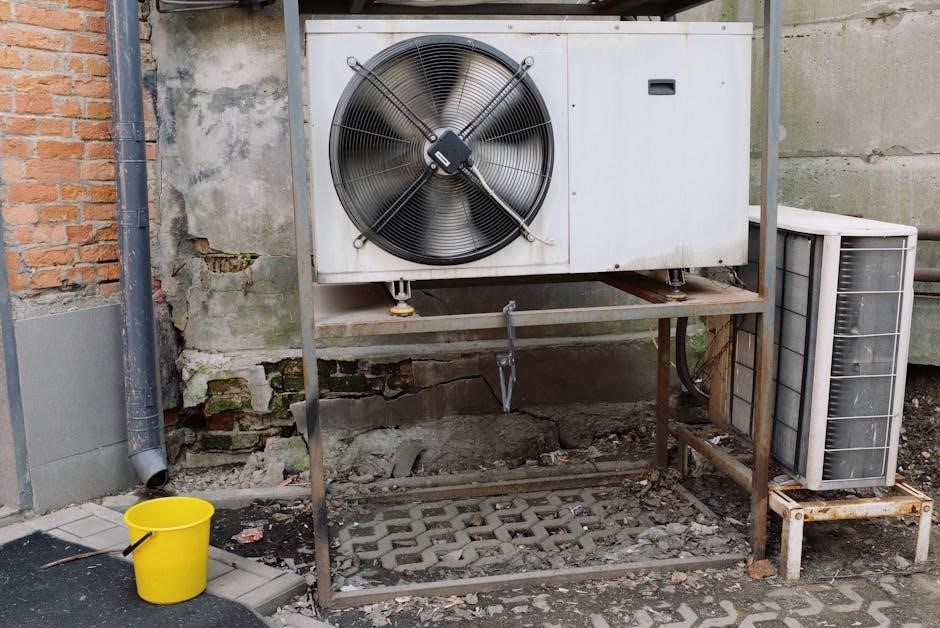GE Portable Air Conditioner Manual: A Comprehensive Guide
This manual provides detailed instructions for safe installation, operation, and maintenance of GE portable air conditioners, ensuring optimal performance and energy efficiency for your cooling needs.
GE portable air conditioners are designed to provide efficient and versatile cooling solutions for various spaces. These units are ideal for rooms where traditional air conditioning systems are not feasible. With a range of models offering advanced features like dehumidification, fan modes, and energy-saving technologies, GE portable air conditioners cater to different cooling needs. They are lightweight, easy to install, and require minimal setup, making them a practical choice for homeowners and renters alike. This manual serves as a guide to understanding and optimizing the performance of your GE portable air conditioner, ensuring it operates safely and efficiently throughout the year.

Safety Precautions and Warnings
Adhere to all safety guidelines to prevent electrical hazards and ensure proper installation. Keep exhaust hoses free from obstructions and avoid exposure to extreme temperatures.
2.1. Important Safety Instructions
- Always follow the instructions in this manual to minimize risks of fire, electrical shock, or injury.
- Ensure the air conditioner is installed in a well-ventilated, dry area, away from direct sunlight and heat sources.
- Keep children and pets away from the unit to avoid accidental damage or harm.
- Do not operate the unit near flammable materials or in areas with high humidity.
- Unplug the unit before cleaning or performing maintenance to prevent electrical hazards.
- Never modify or tamper with the unit’s components, as this can void the warranty and pose safety risks.
- Ensure the exhaust hose is free from obstructions and properly secured during operation.
- Regularly inspect the power cord and plug for damage; replace if necessary.
- Follow all local electrical safety guidelines and building codes.
2.2. Electrical Safety Guidelines
- Use the portable air conditioner with a properly grounded electrical outlet to prevent electrical shock.
- Ensure the power cord is not damaged or frayed; replace it immediately if defects are found.
- Avoid using extension cords, as they may cause overheating or reduce the unit’s performance.
- Install the unit on a stable, level surface to prevent tipping, which could damage electrical components.
- Never expose the power cord or plug to water or moisture, as this can lead to electrical hazards.
- Use a Ground Fault Circuit Interrupter (GFCI)-protected outlet to enhance safety in moist environments.
- Avoid overloading circuits with multiple high-power appliances to prevent electrical fires.
- Do not modify the unit’s electrical components, as this can void the warranty and pose serious risks.
- Always unplug the unit before cleaning or servicing to ensure your safety.

Features and Specifications
GE portable air conditioners offer advanced cooling, dehumidifier modes, and fan functions. They feature compact designs, remote controls, and digital displays for easy operation and energy efficiency.
3.1. Overview of Key Features
GE portable air conditioners are designed for versatility and comfort, offering features like built-in dehumidifiers, fan modes, and digital temperature controls. They are compact, portable, and energy-efficient, with remote control options for easy operation. Some models include advanced functions such as programmable timers, multiple cooling speeds, and auto-restart capabilities. These units are ideal for small to medium-sized spaces, providing efficient cooling without permanent installation. The dehumidifier function helps reduce moisture, while the fan mode circulates air for better comfort. With sleek designs and user-friendly interfaces, GE portable air conditioners are a practical solution for managing indoor climate effectively.
3.2. Technical Specifications and Capacities
GE portable air conditioners vary in cooling capacities, ranging from 5,000 to 14,000 BTU, suitable for spaces from 150 to 400 square feet. Models like GE AHV05 (5,000 BTU) and APSA13YZMW (13,000 BTU) offer efficient cooling with energy-efficient designs. These units are equipped with programmable timers, multiple fan speeds, and dehumidification modes. They operate at noise levels between 38-50 dB, ensuring quiet performance. The portable design includes caster wheels for easy mobility, while the exhaust hose allows for flexible ventilation options. With built-in dehumidifiers and auto-restart functions, these air conditioners provide reliable and consistent cooling, making them ideal for various room sizes and climate control needs.

Installation and Setup
Ensure proper ventilation by placing the unit near a window and using the exhaust hose. Position the air conditioner on a firm, level surface and connect electrical power.
4.1. Unpacking and Preparing the Unit
Begin by carefully opening the box and inspecting the unit for any visible damage. Remove all packaging materials and ensure the air conditioner is placed on a firm, level surface. Check that all accessories, such as the exhaust hose and drainage kit, are included. Before powering on, ensure the area is well-ventilated and free from obstructions. Refer to the manual for specific unpacking instructions tailored to your GE portable air conditioner model. If unsure about any component, consult the provided diagrams or contact customer support for clarification. Proper preparation ensures safe and efficient operation.
4.2. Step-by-Step Installation Guide
Start by positioning the unit in a well-ventilated area, ideally near a window for exhaust hose installation. Attach the exhaust hose to the unit and secure it with the provided screws. Extend the hose through a window or sliding door, ensuring it is free from kinks or bends. For proper drainage, connect the drainage tube to the designated port and direct it to a suitable container or drain. Plug in the air conditioner and ensure the power cord is secure. Follow the control panel instructions to set up your preferred cooling mode and temperature. Double-check all connections to ensure they are tight and properly aligned for optimal performance and safety.

Operating the Portable Air Conditioner
Use the control panel to select modes (Cool, Fan, Dry) and adjust temperature settings. Set the timer for energy-efficient operation and ensure smooth functionality for optimal cooling performance.
5;1. Understanding the Control Panel
The control panel features intuitive buttons for mode selection (Cool, Fan, Dry), temperature adjustment, and timer settings. The digital display shows the set temperature and timer hours. Use the MODE button to switch between cooling, fan, and dehumidify functions. The UP and DOWN arrows adjust the temperature, while the TIMER button sets operation duration. The POWER button turns the unit on/off. Ensure the remote control is correctly paired for seamless operation. Refer to the manual for troubleshooting IR sensor issues. Properly understanding the control panel ensures efficient operation and customizable comfort. Always follow the manual’s guidance for optimal performance and energy efficiency.
5.2. Modes of Operation (Cool, Fan, Dry)
GE portable air conditioners offer three primary modes: Cool, Fan, and Dry. In Cool mode, the unit actively cools the room by circulating refrigerated air, allowing you to set a desired temperature. Fan mode circulates air without cooling, providing a refreshing breeze; Dry mode removes excess moisture from the air, acting as a dehumidifier to prevent dampness. Each mode is selected via the control panel or remote. For optimal comfort, combine modes based on weather conditions. Always ensure the unit is set to the correct mode for your needs to maximize efficiency and performance. Refer to the manual for specific button functions and mode transitions.
5.3. Setting the Temperature and Timer
GE portable air conditioners allow precise temperature control, typically ranging from 61°F to 88°F. Use the control panel or remote to adjust settings. The timer function enables you to set operation duration, from 1 to 24 hours, ensuring energy efficiency. Press the Timer button to cycle through options, with the display showing the set temperature and timer status. For optimal comfort, combine temperature and timer settings to maintain ideal conditions without continuous operation. Always ensure the unit is turned off when not in use to save energy. Refer to the manual for specific button functions and programming instructions to customize your cooling experience effectively.
Maintenance and Care
Regularly clean the air filter to ensure efficient operation and drain excess water to prevent condensate buildup. Check for blockages and inspect for damage to maintain performance.
6.1. Cleaning the Air Filter
Regular cleaning of the air filter is essential for maintaining your GE portable air conditioner’s efficiency and performance. Turn off and unplug the unit before starting. Gently remove the filter from the back or top, depending on your model, and vacuum or rinse it with warm water to eliminate dust and debris. Allow the filter to dry completely before reinstalling to prevent mold growth. Cleaning should be done every 1-2 months or as needed to ensure optimal airflow and cooling. A dirty filter can increase energy consumption and reduce the unit’s ability to cool effectively. Always follow the manufacturer’s instructions for proper cleaning techniques to avoid damaging the filter. This simple maintenance step will help extend the life of your air conditioner and keep your space comfortable.
6.2. Draining Water and Managing Condensate
Regularly draining water and managing condensate is crucial for the smooth operation of your GE portable air conditioner. Turn off the unit and unplug it before attempting to drain. Locate the water drain hose or built-in tank, depending on your model. For models with a drain hose, ensure it is directed to a suitable drainage area. If your unit has a water tank, empty it when the indicator alerts you. Always check for blockages in the drain hose to prevent water accumulation, which can lead to leaks or reduced efficiency. Proper drainage helps maintain airflow and prevents mold growth. For optimal performance, drain the unit periodically, especially in high-humidity environments. Regular maintenance ensures your air conditioner runs efficiently and effectively cools your space.
6.3. Regular Maintenance Checks
Performing regular maintenance checks on your GE portable air conditioner ensures optimal performance and extends its lifespan. Start by inspecting and cleaning the air filter monthly, as a dirty filter reduces efficiency. Check the condenser coil for dust buildup and clean it if necessary. Ensure the drain hose is free of blockages and water flows smoothly. Inspect the power cord and plug for damage, and verify that all connections are secure. Additionally, check the unit for proper leveling to ensure condensate drainage works correctly. Schedule professional maintenance annually to inspect internal components and refrigerant levels. Refer to your manual for specific recommendations tailored to your model. Regular checks help prevent issues and keep your air conditioner running efficiently.

Troubleshooting Common Issues
Address common issues like the unit not cooling, unusual noises, or error codes by checking power supply, filters, and condenser coils. Consult the manual for specific solutions and error code meanings to resolve problems quickly and effectively, ensuring optimal performance and extending the lifespan of your GE portable air conditioner.
7.1. Common Problems and Solutions
Common issues with GE portable air conditioners include the unit not cooling properly, water leakage, or unusual noises. If the unit isn’t cooling, check if the air filter is clean and ensure the room is properly sealed. For water leakage, ensure the condensate drain is properly connected and unblocked. Unusual noises may indicate loose parts or debris inside the unit. Always unplug the device before attempting repairs. Refer to the error codes in the manual for specific troubleshooting guidance. Regular maintenance, such as cleaning filters and checking drain hoses, can prevent many of these issues. If problems persist, contact GE customer support for assistance.
7.2. Error Codes and Their Meanings
GE portable air conditioners display error codes to indicate specific issues. For example, “E1” may signify a sensor malfunction, while “E2” could indicate a refrigerant leak. “E3” often points to a drainage problem or blockage in the condensate system. Understanding these codes helps in diagnosing and resolving issues quickly. If an error code appears, refer to the manual for detailed explanations and suggested solutions. In some cases, resetting the unit or checking connections may resolve the issue. If problems persist, contact GE customer support for professional assistance. Regular maintenance can help prevent errors and ensure smooth operation of your portable air conditioner.

Energy Efficiency and Cost Savings
GE portable air conditioners are designed for energy efficiency, helping reduce energy consumption and lower utility bills. Proper sizing and installation ensure optimal performance and cost savings.
8.1. Energy Efficiency Ratings Explained
GE portable air conditioners feature Energy Efficiency Ratio (EER) ratings, which measure cooling capacity per unit of power consumed. Higher EER values indicate greater efficiency. ENERGY STAR certification ensures models meet strict energy efficiency standards, reducing energy consumption and lowering utility bills. Understanding these ratings helps consumers make informed decisions, balancing performance and cost savings.
8.2. Tips for Optimizing Energy Usage
To optimize energy usage with your GE portable air conditioner, ensure proper ventilation and seal any gaps around windows or doors. Use the timer function to operate the unit only when needed and adjust the temperature setting to a moderate level. Regularly clean the air filter to maintain airflow efficiency. Consider using the eco-mode or energy-saving features if available. Proper installation and placement in a shaded area can also reduce energy consumption. By following these tips, you can lower your energy bills while maintaining effective cooling performance.

Additional Features and Functions
GE portable air conditioners offer advanced features like built-in dehumidifiers, fan modes, and eco-friendly operation, enhancing comfort and efficiency while minimizing energy consumption and maintenance needs.
9.1. Built-in Dehumidifier Function
The built-in dehumidifier function in GE portable air conditioners efficiently removes excess moisture from the air, improving indoor air quality and preventing mold growth. This feature operates seamlessly alongside cooling mode, ensuring a comfortable environment with reduced humidity levels. Users can activate the dehumidifier independently or combine it with other modes for optimal results. The system collects condensate water, which can be drained manually or through a continuous drainage option for added convenience. Regular maintenance, such as cleaning the water tank and ensuring proper ventilation, is essential for maintaining the dehumidifier’s performance. This dual functionality makes GE units versatile for various climates and spaces.
9.2. Fan Mode for Air Circulation
The fan mode on GE portable air conditioners provides a convenient way to circulate air without active cooling, ideal for maintaining airflow in your space. This mode is energy-efficient and suitable for mild weather or when cooling is not required. The control panel allows you to adjust fan speed, ensuring optimal air distribution. Using fan mode can also help reduce energy consumption by allowing natural cooling to take effect. Additionally, it works seamlessly with other features, such as the dehumidifier, to enhance comfort. Regular cleaning of the air filter is recommended to maintain performance. This feature is perfect for creating a refreshing environment while minimizing energy usage.

Warranty and Registration
Registering your GE portable air conditioner is essential for warranty validation. The standard warranty covers parts and labor for up to one year. Refer to the manual for full terms and conditions. For support, visit GE’s official website or contact their customer service team for assistance.
10.1. Registering Your GE Portable Air Conditioner
Registering your GE portable air conditioner is a straightforward process that ensures warranty validation and access to exclusive customer support benefits. To register, visit the official GE Appliances website and navigate to the “Owners Support” section. Select “Appliance Manuals” to access the registration portal. Enter your appliance’s model number, purchase details, and personal information to complete the process. Registration ensures that your product is covered under the manufacturer’s warranty, which typically includes parts and labor for up to one year. For assistance, refer to the Consumer Support section in your manual or contact GE’s customer service team via phone or email. Proper registration also provides access to extended warranty options and priority support services.
10.2. Understanding the Warranty Coverage
Understanding the warranty coverage for your GE portable air conditioner is essential to ensure protection for your investment. The standard warranty typically includes one year of coverage for parts and labor, commencing from the date of purchase. This coverage applies to defects in materials and workmanship under normal use. However, it does not cover damage resulting from misuse, improper installation, or failure to follow maintenance guidelines. Extended warranty options may be available for additional protection. For detailed terms and conditions, refer to the warranty section in your manual or visit the GE Appliances website. Always retain your proof of purchase to validate your warranty claims.

Resources and Support
GE Appliances offers extensive resources, including online manuals, installation guides, and customer support. Visit their website for troubleshooting tips, FAQs, and contact information for assistance.
11.1. Accessing the Full Manual Online
To access the full manual for your GE portable air conditioner, visit the official GE Appliances website. Navigate to the “Owners Support” section at the top of the page. From there, select “Appliance Manuals” to find and download the specific manual for your model. You can search by the product’s model number, ensuring you get the most accurate and up-to-date information. Additionally, GE provides digital copies of use and care manuals, installation guides, and energy efficiency details. This resource is convenient for troubleshooting, understanding features, and maintaining your unit effectively.
11.2. Contact Information for Customer Support
For any inquiries or assistance with your GE portable air conditioner, visit the official GE Appliances website. Navigate to the “Consumer Support” section, where you’ll find helpful resources, including contact information and support options. You can reach customer support via phone by calling 1-800-626-2002, or through email using the contact form provided on their website. Additionally, live chat support is available for immediate assistance. For troubleshooting or repairs, GE offers a comprehensive support network to ensure your unit operates efficiently. Always have your model number ready when contacting support for faster service. This ensures you receive accurate and timely help for any issues or questions you may have.

